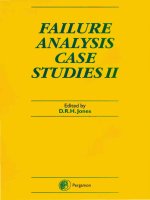FAIZURE ANAZYSIS CASE SZZLDIES II Edited by D.R.H. JonesPergamon ppt
Bạn đang xem bản rút gọn của tài liệu. Xem và tải ngay bản đầy đủ của tài liệu tại đây (12.19 MB, 462 trang )
FAIZURE
ANAZYSIS
CASE
SZZLDIESII
Edited
by
D.R.H.
Jones
Pergamon
Failure Analysis
Case
Studies
I1
FAILURE ANALYSIS
CASE
STUDIES I1
A sourcebook
of
case studies selected
from
the pages
of
Engineering Failure Analysis
1997- 1999
Edited by
D.R.H.
JONES
Department
of
Engineering
University
of
Cambridge,
UK
2001
PERGAMON
An imprint
of
Elsevier Science
AMSTERDAM
-
LONDON
-
NEW
YORK
-
OXFORD
-
PARIS
-
SHANNON
-
TOKYO
ELSEVIER SCIENCE Ltd
The Boulevard, Langford Lane
Kidlington, Oxford
OX5
1
GB,
UK
0
2001
Elsevier Science Ltd. All rights reserved.
This work is protected under copyright by Elsevier Science, and the following terms and conditions apply to its use:
Photocopying
Single photocopies of single chapters may
be
made for personal use
as
allowed by national copyright laws. Permission of the
Publisher and payment of
a
fee is required for all other photocopying, including multiple
or
systematic copying, copying for
advertising or promotional purposes, resale, and all forms of document delivery. Special rates are available for educational
institutions that wish to make photocopies for non-profit educational classroom use.
Permissions may be sought directly from Elsevier Science GlobaI Rights Department,
PO
Box
800,
Oxford
OX5
I
DX,
UK;
phone:
(+44) 1865 843830,
fax:
(+44) 1865
853333,
e-mail:
You may also contact Global Rights
directly through Elsevier’s home page (), by selecting ’Obtaining Permissions’.
In the
USA,
users may clear permissions and make payments through the Copyright Clearance Center, Inc.,
222
Rosewood
Drive, Danvers,
MA01923,
USA; phone:
(+I)
(978) 7508400,
fax:
(+I)
(978) 7504744,
and in the UK through the Copyright
Licensing Agency Rapid Clearance Service (CLARCS),
90
Tottenham Court Road, London
W
1
P OLP, UK; phone:
(+44) 207
63
1
5555;
fax:
(+44) 207 63
1
5500.
Other countries may have a local reprographic rights agency for payments.
Derivative Works
Tables of contents may
be
reproduced for internal circulation,
but
permission of Elsevier Science is required for external resale
or
distribution of such material.
Permission of the Publisher is required for all other derivative works, including compilations and translations.
Electronic Storage or Usage
Permission
of
the Publisher is required to store
or
use electronically any material contained in this work, including any chapter
or
part of a chapter.
Except as outlined above, no part of this work may be reproduced, stored in a retrieval system
or
transmitted in any form
or
by
any means, electronic, mechanical, photocopying, recording
or
otherwise, without prior written permission
of
the Publisher.
Address permissions requests to: Elsevier Science Global Rights Department, at the mail, fax and e-mail addresses noted above.
Notice
No
responsibility is assumed by the Publisher for any injury and/or damage to persons
or
property as a matter of products
liability, negligence
or
otherwise, or from any use
or
operation
of
any methods, products, instructions or ideas contained in the
material herein. Because
of
rapid advances in the medical sciences, in particular, independent verification of diagnoses and drug
dosages should be made.
First edition
2001
Library of Congress Cataloging in Publication Data
A catalog record from the Library
of
Congress has been applied for
British Library Cataloguing in Publication Data
A
catalogue record from the British Library has been applied for.
ISBN:
0
08
043959
4
@
The paper used in this publication meets the requirements ofANSI/NISO
239.48-1992
(Permanence
of
Paper).
Printed in The Netherlands.
PREFACE
It is now three years since Elsevier Science published the first book of Failure Analysis Case
Studies selected fiom volumes
1,2
and
3
of the journal
Engineering Failure Analysis.
The book
has proved to be a sought-after and widely used source of reference material to help people avoid
or analyse engineering failures, design and manufacture for greater safety and economy, and
assess operating, maintenance and fitness-for-purpose procedures.
In
the last three years,
Engineering Failure
Analysis
has continued to build on its early success as an essential medium
for the publication of failure analysis cases studies and papers on the structure, properties and
behaviour of engineering materials as applied to real problems in structures, components and
design.
Failure Analysis Case Studies
I1
comprises
40
case studies describing the analysis of real
engineering failures which have been selected from volumes
4,
5
and
6
of
Engineering Failure
Analysis.
The case studies have been arranged in sections according to the specific type
of
failure mechanism involved. The failure mechanisms covered are overload, creep, brittle
fracture, fatigue, environmental attack, environmentally assisted cracking and bearing failures.
The book constitutes a reference set of real failure investigations which should be useful to
professionals and students in most branches of engineering. My sincere thanks go to the authors
of the case studies for finding the time to communicate their experiences
to
the wider world for
the benefit of us all.
D.R.H.
Jones
May
2001
CONTENTS
Preface
v
Overload failures
Bursting of a silo
R. Kieselbach
3
Shear failure of a road-vehicle steering shaft
J.H. Cleland and
D.R.H.
Jones
1
1
Breakup
of
the firewall between the
B
and C modules
of
the Piper Alpha
platform
-
I.
Analysis by hand calculation
A.C. Palmer
19
Failure of a flexible pipe with a concrete liner
M.
Talesnick and
R.
Baker
3
1
Torsional failure
of
a wire rope mooring line during installation in deep water
C.R. Chaplin
45
Creep failures
Type
I11
creep cracking at main steam line welds
K.G. Sedman,
J.C.
Thornley and
R.M.
Griffin
63
Creep failure of a spray drier
P. Carter
73
Catastrophic failure of a polypropylene tank Part
I:
primary investigation
P.R.
Lewis and
G.W
Weidmann
79
Catastrophic failure of a polypropylene tank Part
11:
comparison of the
DVS
2205
code of practice and the design
of
the failed tank
G.W. Weidmann and
P.R.
Lewis
97
Brittle fracture
Investigation of the
MV
Kurdistan
casualty
S.J.
Garwood
117
Investigation of failed actuator piston rods
T.F. Riitti and
E.J.
Wentzel
139
Premature failure of prestressed steel bars
A. Valiente and
M.
Elices
147
Premature fracture of a composite nylon radiator
P.R. Lewis
157
Vlll
Fatigue
Catastrophic failure of a raise boring machine during underground reaming operations
A. James
175
Fatigue failure of the de Havilland Comet I
P.A. Withey
185
Low-cycle fatigue of titanium 6A1-4V surgical tools
H. Velasquez, M. Smith, J. Foyos, F. Fisher.
O.S.
Es-Said and
G.
Sines
193
Failure analysis and experimental stress analysis of a threaded rotating shaft
R.B. Tait
199
An investigation of the failure of low pressure steam turbine blades
N.K. Mukhopadhyay,
S.
Ghosh Chowdhury,
G.
Das,
I
Chattoraj, S.K. Das and
D.K. Bhattacharya
211
Vibration-induced fatigue failure of an impulse line
K.R.
Al-Asmi and A.C. Seibi
225
Malfunctions of a steam turbine mechanical control system
J.H. Bulloch and A.G. Callagy
235
Fatigue failure of hold-down bolts for a hydraulic cylinder gland
C. Tao, N. Xi,
H.
Yan and Y. Zhang
241
Analysis
of
a vehicle wheel shaft failure
J. Vogwell
247
Fatigue failure analysis of a leg press exercise machine
P.J.Vernon and
T.J
Mackin
255
Failure analysis of rubber fuel pipes in aero-engines
G.
Fu
267
Environmental attack
Failure of austenitic stainless steel components used
in
nitrogen oxide plant
V.M.J. Sharma, A.K. Jha, P. Ramesh Narayanan,
S.
Arumugham and
T.S.
Lakshmanan
277
Corrosion of central heating systems
D.R.H.
Jones
285
Crevice corrosion
of
3
16L
caused by chloride partition in water-butanone mixtures
J.H. Cleland
301
Type
I
pitting of copper tubes from a water distribution system
P.J.L. Fernandes
307
Corrosion of flexible waveguides
D.
Papatheodorou, M. Smith and
O.S.
Es-Said
3 13
Failure of automobile seat belts caused by polymer degradation
J.M. Henshaw, V.
Wood
and
A.C. Hall
317
Oxidation failure of radiant heater tubes
K.B. Yoon and D.G. Jeong
33
1
Environmentally assisted cracking
Sustained
load
crack growth leading to failure in aluminium gas cylinders in traffic
J.W.H. Price, R.N. Ibrahim and D. Ischenko
345
Hydrogen-assisted stress-corrosion of prestressing wires in a motonvay viaduct
L.
Vehovar,
V.
Kuhar and A. Vehovar
357
ix
Failure analysis
of
camer chain pins
G.A.
Slabbert,
J.J.
McEwan and
R.
Paton
365
Unusual cases of weld-associated cracking experienced in a high temperature
catalyst reduction reactor
M.L.
Holland
373
Hydrogen cracking
of
ferritic stainless steel thermal storage tanks
S.
Konosu and
T.
Nakaniwa
383
Hydrogen embrittlement failure of hot dip galvanised high tensile wires
N.K.
Mukhopadhyay,
G.
Sridhar,
N.
Parida,
S.
Tarafder and V.R. Ranganath
393
Bearing
failures
Contact fatigue in rolling-element bearings
P.J.L.
Fernandes
409
An air crash due to fatigue failure
of
a ball bearing
I. Salam,
A.
Tauqir,
A.
U1
Haq and
A.Q.
Khan
415
Failure analysis of a condensate pump shaft
A.M.
Lancha,
M.
Serrano and
D.
Gdmez
Briceiio
425
Author Index
443
Overload failures
Failure Analysis
Case
Studies
II
D.R.H.
Jones (Editor)
0
2001
Elsevier Science Ltd.
All
rights reserved
3
BURSTING OF
A
SILO
R.
KIESELBACH
Failure Analysis of
Metals,
Swiss
Federal Laboratories for Materials Testing and Research,
Oberlandstrasse 129,
CH-8600
Dlfbendorf, Switzerland
(Received30
Augmf
1996)
Abstract-This paper describes
the
bursting
of
a
large
silo on a farm, which
caused
considerable environmental
damage and cost. The
cause
was
misuse
of the silo for vegetable
slurry
instead of for
feed
for livestock, and
overfilling the
silo.
0
1997
Elsevier
Science Ltd. All rights reserved.
Key
words:
silo, failure,
rupture,
hydrostatic pressure
1.
INTRODUCTION
Most of the accidents in connection with silos are due to suffocation or gas poisoning
of
the farmers
entering
a
silo. Some are also caused by the explosion of methane, which is produced by fermentation
of the forage. Cases of bursting or explosion are, nevertheless, rather rare.
In the present case, three identical silos had been built on a farm, each with a diameter of 6m
(20 ft) and a height of nearly
25
m (80 ft). The hull of the vessels was made of steel plates measuring
1.4
x
2.68 m, and the thickness of the sheets vaned from
5.7
mm at the bottom to
2.4
mm at the
top. All in
all,
the silo consisted of 16 rings and one base ring. The individual sheets had been
protected against corrosion by enamelling, and were joined by bolts and nuts. The joints were
protected against corrosion by a special kind
of
mastic. The total capacity
of
a silo was approximately
630 m3.
Since the farm no longer had any use for the silos, they were rented to a feed company for the
storage of feed for pigs. The
slurry
was delivered in tank cars and pumped into the silo. The silo
was filled up repeatedly in the following months. Finally,
a
few minutes after a delivery, when the
tank car had just left the site, the silo burst and spilled its contents, a slightly sour slurry. The
collapse of the top
of
the silo also damaged the next, still empty silo, which buckled and also
collapsed partially. The spilled slurry caused considerable environmental damage in addition to the
cost
of
the silos and the cost of the interruption to service. According to the lorry driver, the
silo
had been, at that time, approximately three-quarters full, and the manhole lid had not been fastened,
but only laid loosely on its flange.
2.
INVESTIGATIONS AND TESTS PERFORMED
2.1.
Visual inspection
The site of the accident was visited and the following observations could be made (see Figs 1-3).
Silo
3
had failed and was severed above the seventh ring (counted from the bottom), where a
reinforcement ring was attached.
A
zone, four rings high, had been separated, and hung partially
on the silo, partially on the ground. The contents of the silo had spilled for approximately 30 m in
a
semicircle uphill and
200
m downhill. The pasture had been destroyed, the slurry being slightly
sour after lactic acid fermentation.
The detached rings were separated into several pieces, and were in some places still immersed in
a
pool
of
slurry, such that it was difficult to make out where the pieces had belonged. Failure had
Reprinted
from
Engineering Failure Analysis
4
(l),
49-55 (1997)
4
Fig.
1.
Damaged
silos:
view
of
the site.
kli-
I
,
,./
,
i
,
(,,
,
,
Fig
2.
Bolted joints of the sheets used for the silo
In
the lower part, a reinforcement nng was attached
occurred by rupture of the boltholes of the vessel in circumferential and longitudinal directions
(Fig.
4).
After the search had been carried out, specimens were taken, as detailed in Table
1.
After the accident, the silo was still full
up
to the seventh ring (counted from the bottom), as can
be seen from
Fig.
5.
5
E
s
cu
N
i
rn
Dia.
___(
2.4
2.4
2.4
2.4
2.4
2.4
2.4
3.4
3.4
3.4
4.2
4.2
5.0
5.7
5.7
5.7
Fig.
3.
Schematic drawing of the silo, showing the location of the rupture:
(I)
level theoretically necessary for
bursting by hydrostatic pressure;
(11)
level for filling with
407
t;
(111)
permissible filling for density of 1.05 kg
I-';
(IV)
level after bursting.
!
I
Fig.
4.
Longitudinal bolted joint, presumably at location of start
of
rupture
Table
1.
Specimens and samples taken
A
B
C
D
E
F
G
-
One sheet/plate with a failed circumferential bolted connection
One plate containing an intact circumferential joint
One plate containing an intact longitudinal joint
Samples of slurry
on
site
Samples of slurry retained at the manufacturer of the slurry
Textile fibres from an airbag at the top of the silo
Two safety valves from the top of the silo
6
Fig.
5.
Top view
of
failed silo, showing remaining filling level.
2.2.
Tests
for
traces
of
an explosion
Specimens
F
were subjected to laboratory tests to detect possible traces of heat influence by fire
or explosion.
No
such traces could be found. Thus, one can conclude that failure was not caused
by the explosion
of
methane
or
any other gas produced in the silo by fermentation.
2.3.
Tensile tests
The sheet metal was tested using specimens
BR,
CR,
BP
and
CP,
as shown
in
Fig.
6
and
Table
2.
Fig
6.
Specimens for mechanical tests.
Table
2.
Results of tensile tests on sheet material from silo
Yield
Tensile
Reduction
Elongation Uniform
strength
strength of area
(5
diameters) elongation
Specimen Orientation
(N~II-~)
(N~II-~)
(”/)
(”/I
(”/)
BR
I
to joint
288 341 18
44.5
25
CR
I
to joint
261 316
I1
47.5
24
BP
11
to joint
300 345
IS
43 24
CP
1)
to joint
278 313
70
46.3 29
7
30
-
20-
f
fi.2
I
I
I
I
I
5
10
15
20
25
AI
[mml
Fig.
7.
Behaviour
of
bolted joints in tension tests.
Specimens B.
1,
B.2,
C.
1
and C.2 were tested for the strength
of
the bolted joints. From Fig.
7,
it
can be seen that they started to yield between loads
of
15 and 25 kN, and that the deformation
before fracture was in most cases more than 25 mm.
2.4.
Determination
of
the density
of
the slurry
density
of
1.05
kgl-I.
Four samples
E
gave an average density
of
1.035 kgl-'. Sample
D
taken from the site had a
3.
NUMERICAL EVALUATIONS
3.1.
Determination
of$lling
level
from
records
of
the user
After the accident, the user
of
the silo supplied notes
of
deliveries, from which the theoretical
This height corresponds
to
filling up to the upper edge of ring
7
(counted from the top).
filling level at the time of the accident could be calculated (Table 3).
3.2.
Stress analysis
of
boltedjoint
material, with
Rpo.2
=
283 MPa and
R,
=
330 MPa. This gives for shear:
The average values for yield and ultimate strength are provided by the tensile tests on the sheet
z0.2,pem
=
3
=
163 MPa,
Rm
191MPa.
zm*-
=
fi
=
For one bolt, at
a
distance
of
25.4mm from the edge
of
the sheet, one obtains
Fo.2
=
~~.2,~,,,,
x
2.4
x
25.4
x
2
=
19.9
kN,
(3)
Table
3.
Calculation
of
filling
level
from records
Contents according to bookkeeping notes 407,790
kg
Density according to tests, maximum
1.05
kgl-'
Base area
of
silo
(inside) 27.98m2
Theoretical
level
13.9m
8
F,
=
x
2.4
x
25.4
x
2
=
23.3 kN.
(4)
3.3.
Assessment
of
the theoretical bursting pressure
This also corresponds to the mean value of the forces calculated from Eqns (3) and (4).
In the test, the lower bound for the strength of the bolted joint was measured as
FFractuIe
=
22 kN.
From the spacing of the bolts
(108
mm), one obtains the force at fracture per unit length:
22
x
103
T=
-
204Nmm-’.
108
The burst pressure can be calculated from this, using the diameter of the silo (6m), as
2
x
204
6000
-
0.068
Nmm-’.
Pburst
=
__
-
The corresponding level over the ruptured ring is
This
is
equivalent to the height of 4.7 rings of the silo, and would mean that the level of the slurry
was approximately in the middle of the third ring (counted from the top).
3.4.
Spurting distance
From the visual inspection at the site of the accident, the approximate spurting distance of the
slurry of 30m is known. Since this was not a simple parabolical throw, but the jet was dispersed
further after hitting the ground, the process can only be calculated approximately. The intention of
such an assessment is, of course, to determine the filling height of the silo.
The horizontal velocity of the jet is given by
u=
qSH, and from the distance the jet travelled
one obtains
9
=
Dd2(HL
-
Ah)
’
Thus, the height of the liquid above the leak is
d*
=
S/D
is
the portion of the distance that the jet travels after hitting the ground,
cp
is the factor
of constriction of the jet (normally
cp
I
I),
and the other symbols are explained by Fig.
8.
If different
___
___~
D
-30
m
~~-
~ ~
Fig
8
Schematic view of the spurting of the slurry from the
silo
9
levels
HL
for the first leak and different ratios of sloshing
(d*
=
6/D)
are assumed, it can be seen
from Fig.
9
that the silo must have been filled to the top, and the liquid must have sloshed relatively
far after hitting the ground to have produced the observed pattern on the site.
4.
CONCLUSIONS
Thc visual inspection at the site
of
the accident showed the typical picture of failure by
overpressure. Indications
of
an explosion
or
a chemical reaction, which could have produced
the overpressure, were not found. A pressure above atmospheric pressure can also be excluded
because the necessary safety devices were installed and operative.
According to the manufacturer
of
the silo, it was permissible to fill the silo with liquid up to
the seventh ring (counted from the bottom), i.e.
ca
10
m high.
The amount of 407 t, admitted by the user, corresponds to a filling height of
ca 14m.
The assessment of the filling height from the observed spurting distance also points to
a
filling
level practically at the top of the silo.
The design, manufacture and assembly of the
silo
can be judged as proper, suitable and
according to normal engineering practice.
Tests on the material also indicate
a
higher level than the seventh ring (counted from the
bottom). This is supported by the observed deformations in the failed bolted joint of the silo.
An additional argument against the statement of the user related to the filling level is the fact
that the silo was still filled to the middle of the tenth ring (counted from the top), although
the whole neighbourhood was covered with slurry from the silo.
Based on these findings it can be said that failure of this silo was caused by filling it
to
too
high
a
level with liquid instead of forage.
It cannot be completely excluded that
a
mix-up in the way of counting the rings has contributed
to the failure. Whereas one would normally count the rings starting from bottom, as for
buildings, the manufacturer of the silo counts the rings starting from top, because the
silo
is
erected that way, assembling first the top, then putting rings under the top ring until the
intended height of the silo is reached.
Acknowledgemenf-The calculations were performed by
R.
Primas,
Section Materials and Structural MechdnicsiJoining
Technology
of
EMPA.
Failure Analysis Case Studies
N
D.R.H. Jones (Editor)
0
2001 Elsevier Science Ltd. All rights reserved
11
SHEAR FAILURE OF A ROAD-VEHICLE STEERING
SHAFT
J.
H.
CLELAND
Cambcor Ltd,
30
Windsor
Road,
Cambridge CB4 3JW, U.K.
and
D. R.
H.
JONES*
Department of Engineering, University of Cambridge, Trumpington Street, Cambridge CB2
lPZ,
U.K.
(Received
20
September
1996)
1.
BACKGROUND
This case study describes the failure analysis of a fractured steering shaft from a heavy road vehicle
which had been involved in a collision. The investigation was carried out in order to establish
whether the failure was the cause or a consequence of the accident.
Figures
1
and
2
are scale drawings of the steering shaft. The shaft was supported by two needle
.
.
.
.
.
.
. .
:
_.
m
IS
J
L-3s
-
_
c
._
Fig.
1.
Side view of the steering shaft. Dimensions in
mm.
D
*Author to whom correspondence should be addressed.
Reprinted
fkom
Engineering Failure Analysis
4
(I),
8
1-88 (1997)
12
I
c
F
I
End view
of
the steering shaft. Dimensions Fig.
2.
in
mm.
roller bearings. Between the bearings was
a
toothed sector, which was driven by a worm connected
to the steering wheel. The steering arm, which transmitted movement to the track rods, was attached
to the end
of
the shaft by a splined connection.
As
shown in Fig.
3,
the steering shaft had been
subjected to
a
torsional overload.
As
a consequence of the overload, the splined section of the shaft
had been twisted permanently (the ends
of
the splines were offset by 1.3mm), and the shaft had
fractured where it met the toothed sector. The twisted splines are shown in Fig.
4,
and the matching
fracture surfaces are shown in Fig.
5.
Most of the fracture surface was relatively flat and smooth,
but there was a region near the centre which was comparatively rough. Figure
6
is a view taken in
the scanning electron microscope
of
the flat part of the fracture surface, which shows the classic
features of shear failure. Figure
7
is a scanning electron micrograph taken from the rough part of
the fracture surface, which shows the classic features of fibrous tensile failure. There were no
indications of prior defects on the fracture surface.
t
171
_
.
Fracture
':I
Fig.
3.
Side
view
of
the shaft, showing the
plane
of
the fracture and the region of torsional overload.
Dimensions
in
mm.









